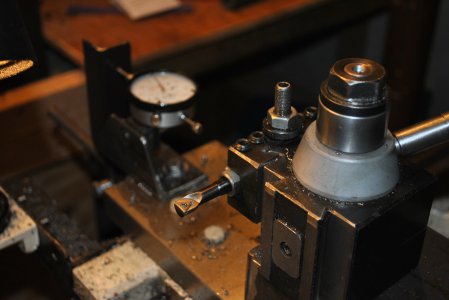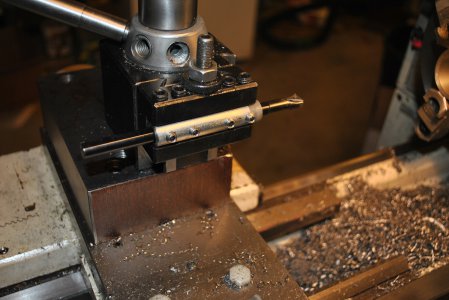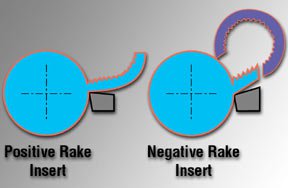-
Welcome back Guest! Did you know you can mentor other members here at H-M? If not, please check out our Relaunch of Hobby Machinist Mentoring Program!
You are using an out of date browser. It may not display this or other websites correctly.
You should upgrade or use an alternative browser.
You should upgrade or use an alternative browser.
Boring Bar Sings
- Thread starter epanzella
- Start date
- Joined
- Jul 26, 2011
Have you tried running the lathe as slow as it will go? It will take longer to bore the hole,but might stop the singing.
Sometimes when I can't get a wide cut forming tool to not chatter,I turn the lathe over by hand and feed the cutter in until it smooths the cut up. This always works,but not the thing for your case. But,something to keep in your bag of tricks.
Sometimes when I can't get a wide cut forming tool to not chatter,I turn the lathe over by hand and feed the cutter in until it smooths the cut up. This always works,but not the thing for your case. But,something to keep in your bag of tricks.
- Joined
- Apr 8, 2013
Being as the bar uses a carbide insert I didn't think of running it slow. I tried all the speeds my G4003G will produce between 360 and 1400rpm. It will go down to 70rpm so I'll give that a try. Thx.Have you tried running the lathe as slow as it will go? It will take longer to bore the hole,but might stop the singing.
Sometimes when I can't get a wide cut forming tool to not chatter,I turn the lathe over by hand and feed the cutter in until it smooths the cut up. This always works,but not the thing for your case. But,something to keep in your bag of tricks.
- Joined
- Apr 8, 2013
This morning I finished the sleeve that allows me to adjust the rake angle of that bar. I set it at zero rake and the thing cut like a champ with zero chatter and a decent finish. Didn't even experiment yet to find the best speed/feed, just pulled 600rpm out of the hat and tried it. I don't get it. Why would the factory machine flats on this bar to force you to use a rake angle that doesn't work? Am I missing something here?




- Joined
- Dec 20, 2012
You purchased a negative rake bar that is machined to the correct angle for its intended use - heavy cutting loads. The inserts typically have little to no clearance angle under the cutting edge, which makes them stronger and allows you to have 6 cutting edges per insert instead of just 3. The clearance angle required to prevent rubbing is achieved by holding the insert at that negative rake angle the machined flat holds the bar at. The manufacturer did not make the bar wrong; you bought the wrong bar for your application. Sorry.
Turning the bar to zero or near-zero rake will work as you found, but you have very little clearance angle under the cutting edge. Deep cuts will not go well when the bottom of the insert contacts the bore. It gets even worse when the bore size is smaller as this really eats up the clearance under the insert. Best case for this bar is to use it to hog through holes; it will work really well for that.
You might consider buying another bar. For the application you have here where you must cut to a shoulder I would suggest a 5 degree positive lead bar to reduce chatter at the bottom of the bore. This type of bar cuts at the tip of the cutter as opposed to the entire front edge of the insert like a zero-lead bar does; this gives a superior cut on a flat bottom bore. If the bar you need is available with a positive axial rake insert I would also recommend that. A positive axial rake insert will substantially reduce tangential cutting forces, improving accuracy and finishes. I also suggest you avoid chip breaker inserts unless you have a specific need for them; they tend to increase cutting forces so you need more power and more rigidity to use them. Flat topped inserts work really well for most uses anyway. Lastly, pay close attention to the nose radius of your inserts. In general, boring is not a heavy cutting process with a lot of stock removal per pass and since your depth of cut and feed rate are closely tied to your nose radius it is wiser to go smaller than larger. I suggest something in the 0.007-0.008" nose radius range for most work and even smaller for fine finishes or smaller bores.
There are many brands to choose from. I prefer Circle Machine carbide bars myself and have had very positive results with them.
Edit: I should add that when setting cutting height, set the tip of the insert to center height, then raise it about 0.005-0.010". This will help accommodate the tangential cutting forces inherent in the boring process.
Turning the bar to zero or near-zero rake will work as you found, but you have very little clearance angle under the cutting edge. Deep cuts will not go well when the bottom of the insert contacts the bore. It gets even worse when the bore size is smaller as this really eats up the clearance under the insert. Best case for this bar is to use it to hog through holes; it will work really well for that.
You might consider buying another bar. For the application you have here where you must cut to a shoulder I would suggest a 5 degree positive lead bar to reduce chatter at the bottom of the bore. This type of bar cuts at the tip of the cutter as opposed to the entire front edge of the insert like a zero-lead bar does; this gives a superior cut on a flat bottom bore. If the bar you need is available with a positive axial rake insert I would also recommend that. A positive axial rake insert will substantially reduce tangential cutting forces, improving accuracy and finishes. I also suggest you avoid chip breaker inserts unless you have a specific need for them; they tend to increase cutting forces so you need more power and more rigidity to use them. Flat topped inserts work really well for most uses anyway. Lastly, pay close attention to the nose radius of your inserts. In general, boring is not a heavy cutting process with a lot of stock removal per pass and since your depth of cut and feed rate are closely tied to your nose radius it is wiser to go smaller than larger. I suggest something in the 0.007-0.008" nose radius range for most work and even smaller for fine finishes or smaller bores.
There are many brands to choose from. I prefer Circle Machine carbide bars myself and have had very positive results with them.
Edit: I should add that when setting cutting height, set the tip of the insert to center height, then raise it about 0.005-0.010". This will help accommodate the tangential cutting forces inherent in the boring process.
- Joined
- Apr 8, 2013
So that bar is for heavy cutting loads. I tried DOC's .005" to .040" @ .001" to .004" /revolution in steel that machines fairly well. The bar is only 3/8 diameter and I'll need about 1 3/8 penetration. Should I have been making heavier cuts than that? The singing didn't seem to get better or worse with any combination. I tried 360 to 1400 rpm.You purchased a negative rake bar that is machined to the correct angle for its intended use - heavy cutting loads. The inserts typically have little to no clearance angle under the cutting edge, which makes them stronger and allows you to have 6 cutting edges per insert instead of just 3. The clearance angle required to prevent rubbing is achieved by holding the insert at that negative rake angle the machined flat holds the bar at. The manufacturer did not make the bar wrong; you bought the wrong bar for your application. Sorry.
- Joined
- Sep 4, 2013
Re: Boring Bar Sings. Try a suitable length of good old solid solder; wrap tightly&tape
See title above .... BLJHBThe boring bar pictured below sings like a canary and I can't seem to stop it. It bores "OK" but although I can't feel the chatter with my fingernail in the bored surface I can see the herringbone. I've got a project coming up that requires boring to a square shoulder that has to seal against 40,000 psi and I know if that bar is singing now when it gets to that shoulder it's gonna dance. I've tried lots of feed/speed and tool height combinations with no luck. The machine is a Grizzly G4003G and it parts like a champ so I know it's rigid. My other bars cut great but won't fit in a .458 hole. It sings with the amount of projection shown in the photos and that is approximately the depth I'll need for the project. The bar looks to have 15 degree negative rake built into it via flats on the top & bottom. If the rake angle is the problem I can make a holder that will allow changing the angle. Any thoughts?
- Joined
- Dec 20, 2012
So that bar is for heavy cutting loads. I tried DOC's .005" to .040" @ .001" to .004" /revolution in steel that machines fairly well. The bar is only 3/8 diameter and I'll need about 1 3/8 penetration. Should I have been making heavier cuts than that? The singing didn't seem to get better or worse with any combination. I tried 360 to 1400 rpm.
The bar is meant for heavier cutting loads when used in its normal configuration. It will not work the same when turned to a zero-rake position because now you have very little clearance under the edge and the insert may rub at some point. What this point is, I don't know - you'll have to try it.
Let me try to clarify this clearance thing. I copied this off the net:

You can see how both a positive and negative rake insert have the same clearance angles under the cutting edge when their respective bars are held in the holder as intended. What you have done here is to rotate the negative rake bar so that the top of the insert is now flat but as a consequence the angle under the edge has all but disappeared. The bar will cut, no doubt, but how deep you can go before the lower part of the insert rubs and causes chatter is not clear.
My advice is to be conservative so you can finish your bore. By conservative I mean roughing cuts at NR + 0.005" or so. If your nose radius is 0.015", then a reasonable roughing cut would be 0.020" and a reasonable finishing cut would be 0.005". If it does not rub and the cut goes well then I would stay with that and not push it. The reason I would personally not push it is because rubbing will affect accuracy and finish and I cannot tell you when the rubbing will affect the cut.
I hope that clarifies this for you.

- Joined
- Apr 8, 2013
The speeds & feeds I quoted were with the bar in it's normal position with the neg rake. I didn't go heavier than .040 doc because it's only a 3/8 bar. Your post did make me realize two things. Although the bar didn't cut well with the original insert, I have replaced that one with the same ones that I use for the rest of my insert bars which are for external cuts. This may be a contributor. The second thing you made me realize is that although this bar cuts great at zero rake I tried it in a one inch hole, not the .458 hole that I'll be using it in on my project. It's possible that I won't have sufficient clearance in the smaller hole. I'll have to try it in some scrap. At lest with the adaptor I made I can use any rake angle I want including the factory angle. Thx for the help.The bar is meant for heavier cutting loads when used in its normal configuration. It will not work the same when turned to a zero-rake position because now you have very little clearance under the edge and the insert may rub at some point. What this point is, I don't know - you'll have to try it.
Let me try to clarify this clearance thing. I copied this off the net:
View attachment 77892
You can see how both a positive and negative rake insert have the same clearance angles under the cutting edge when their respective bars are held in the holder as intended. What you have done here is to rotate the negative rake bar so that the top of the insert is now flat but as a consequence the angle under the edge has all but disappeared. The bar will cut, no doubt, but how deep you can go before the lower part of the insert rubs and causes chatter is not clear.
My advice is to be conservative so you can finish your bore. By conservative I mean roughing cuts at NR + 0.005" or so. If your nose radius is 0.015", then a reasonable roughing cut would be 0.020" and a reasonable finishing cut would be 0.005". If it does not rub and the cut goes well then I would stay with that and not push it. The reason I would personally not push it is because rubbing will affect accuracy and finish and I cannot tell you when the rubbing will affect the cut.
I hope that clarifies this for you.
- Joined
- Dec 20, 2012
The second thing you made me realize is that although this bar cuts great at zero rake I tried it in a one inch hole, not the .458 hole that I'll be using it in on my project. It's possible that I won't have sufficient clearance in the smaller hole. I'll have to try it in some scrap. At lest with the adaptor I made I can use any rake angle I want including the factory angle. Thx for the help.
You are absolutely right - the smaller the bore, the faster the clearance angles are eaten up. This is why inserts made for tiny bores have 11 degree clearance angles, or more, under the cutting edge.
Best of luck with that bore!

